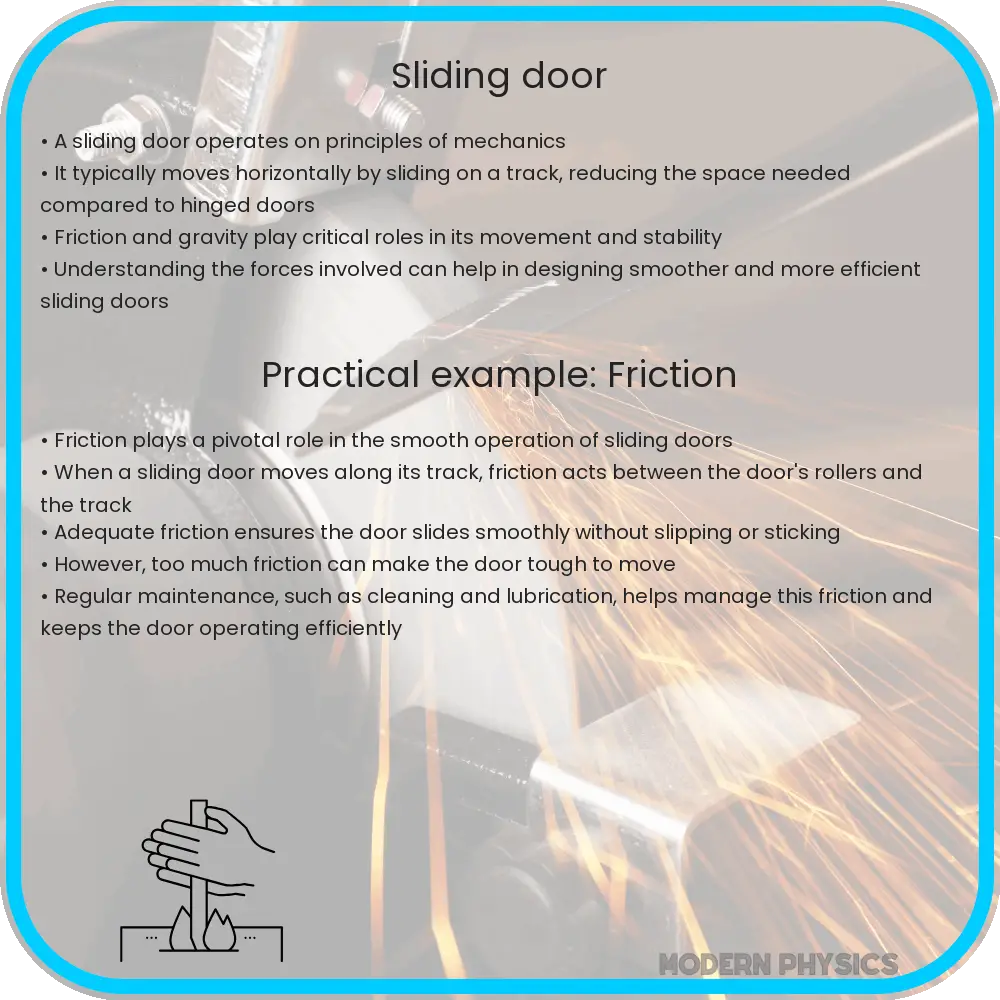Explore the mechanics of sliding doors, focusing on efficiency, advanced materials, design considerations, and the latest technological innovations.

Understanding Sliding Door Mechanics: A Deep Dive into Efficiency, Force, and Motion Dynamics
The mechanics of sliding doors encompass a fascinating blend of physics, engineering, and materials science. To grasp their efficiency and the dynamics of force and motion involved, it is essential to delve into the fundamental principles governing their operation. This exploration not only reveals the intricate design considerations but also sheds light on how these principles can be optimized for better performance and sustainability.
Efficiency in Sliding Door Systems
Efficiency in sliding doors is primarily gauged by their ease of motion and energy conservation. The key to achieving high efficiency lies in reducing friction and resistance during the door’s operation. This is often accomplished through the use of specialized materials for the door tracks and rollers. For instance, materials like nylon or PTFE (Polytetrafluoroethylene) reduce friction significantly compared to traditional metal-on-metal systems. Additionally, the alignment and precision in the installation play a crucial role in minimizing energy loss and ensuring smooth operation.
Force and Motion Dynamics
The dynamics of force and motion in sliding doors are governed by Newton’s laws of motion. The most pertinent being Newton’s Second Law, stated as F = ma (Force = mass x acceleration). In the context of sliding doors, the force applied by a user is translated into the movement of the door. The mass of the door and the frictional force between the door and its track determine the amount of force required to initiate and sustain motion.
Optimizing Force Application
To optimize the force applied on sliding doors, it’s essential to consider the door’s weight and the friction coefficient of the track system. Lighter doors require less force to move, but structural integrity and security must not be compromised. The choice of roller and track materials is critical here, as they directly influence the friction coefficient. A lower coefficient means smoother motion with less force.
Understanding Motion Dynamics
The motion of a sliding door can be described using kinematic equations, which consider the door’s velocity, acceleration, and displacement. These equations help in predicting the door’s behavior under different force applications and can be crucial in designing door systems for specific requirements, like in high-traffic areas or for accessibility purposes.
In summary, the mechanics of sliding doors involve a delicate balance of material science, physics, and engineering principles. By optimizing materials and design, we can achieve higher efficiency and better performance in sliding door systems. The next part of this article will delve into material choices, design considerations, and advanced technologies in sliding door mechanics.
Advanced Material Choices in Sliding Door Design
When it comes to material selection for sliding doors, the focus is on durability, weight, and friction characteristics. Materials like tempered glass, lightweight aluminum, and even composites offer a balance between strength and weight. The use of tempered glass, for instance, ensures safety while providing an aesthetic appeal. Aluminum, known for its lightness and corrosion resistance, makes an excellent choice for the door frame. Composites, on the other hand, can be engineered to offer specific properties like enhanced insulation or soundproofing.
Design Considerations for Enhanced Performance
Design plays a pivotal role in the functionality of sliding doors. Features like double-track systems, where one track supports the door and the other guides its movement, can significantly improve stability and smoothness. The incorporation of automatic door systems, which use sensors and motors to control the door’s movement, can enhance user convenience and accessibility. Moreover, the design should ensure that maintenance requirements are minimal, and the door system remains reliable over time.
Technological Advancements in Sliding Door Mechanics
Technological advancements have revolutionized sliding door systems. The integration of smart technology allows for automated control of the doors, which can be linked to security systems or smart home networks. Energy efficiency can also be enhanced through the use of thermal break technology in frames, which reduces heat transfer and helps in maintaining indoor temperatures. Additionally, innovations in soundproofing technologies ensure that sliding doors offer not just functionality but also contribute to a serene indoor environment.
Conclusion: The Future of Sliding Door Mechanics
The mechanics of sliding doors represent a perfect blend of physics, engineering, and material science, and their evolution is continuous. Modern sliding door systems are not just about providing a means of entry and exit; they are integral components of architectural design, contributing to the aesthetic, functionality, and energy efficiency of buildings. With advancements in materials and technology, the future of sliding door systems looks promising, aiming to offer even higher efficiency, better user experience, and integration with smart home technologies. As we continue to innovate, sliding doors will undoubtedly become more sophisticated, blending seamlessly with our evolving living and working spaces.
